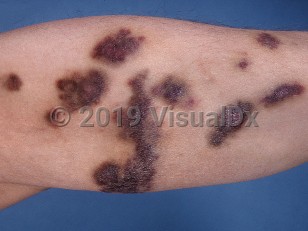AIDS-associated Kaposi sarcoma
See also in: External and Internal Eye,Anogenital,Oral Mucosal LesionAlerts and Notices
Important News & Links
Synopsis

Kaposi sarcoma (KS) is a malignant neoplasm of lymphatic endothelial cell origin that occurs in several forms: AIDS-associated and non-AIDS-associated. Subtypes of non-AIDS-associated KS include classic KS, African endemic KS, and iatrogenic KS. All types of KS are due to or influenced by human herpesvirus type 8 (HHV-8), and cutaneous findings are clinically and histologically indistinguishable among the types.
The outbreak of KS among young, previously healthy men who have sex with men (MSM) heralded the recognition of AIDS in 1981. AIDS-associated KS is the most common neoplasm in human immunodeficiency virus (HIV)-seropositive patients and is an AIDS-defining illness. This form of KS is primarily seen in the MSM population, but it can be seen in female partners of men with the disease in addition to HIV-infected women. Lesions may worsen during immune reconstitution inflammatory syndrome and may also appear in patients with HIV who have received long-term antiretroviral therapy (ART).
Patients with AIDS-associated KS often have multifocal cutaneous disease. Around 20% of patients will have concomitant visceral involvement, which places these patients at risk for hemorrhage from gastrointestinal (GI) lesions, cardiac tamponade, and pulmonary obstruction. Additionally, AIDS-associated KS is more likely than classic KS to display a rapidly progressive course.
Spindle cells of endothelial origin are the predominant cells affected. In the latent phase, HHV-8 antigens promote cell proliferation by inactivating the RB gene, which leads to transcription of S-phase genes and blocks apoptosis via p53 and p27Kip1 suppression. In the lytic phase, when tumor formation is noted, thousands of virion particles are assembled, resulting in cell lysis. HHV-8 requires additional cofactors for the development of KS. HIV coinfection acts as a stimulant for HHV-8 viral lytic expression and via its suppression of the immune system.
The introduction of ART dramatically decreased the incidence, morbidity, and mortality of AIDS-associated KS.
For discussion of classic, endemic, and iatrogenic forms of KS, see non-AIDS Kaposi sarcoma.
The outbreak of KS among young, previously healthy men who have sex with men (MSM) heralded the recognition of AIDS in 1981. AIDS-associated KS is the most common neoplasm in human immunodeficiency virus (HIV)-seropositive patients and is an AIDS-defining illness. This form of KS is primarily seen in the MSM population, but it can be seen in female partners of men with the disease in addition to HIV-infected women. Lesions may worsen during immune reconstitution inflammatory syndrome and may also appear in patients with HIV who have received long-term antiretroviral therapy (ART).
Patients with AIDS-associated KS often have multifocal cutaneous disease. Around 20% of patients will have concomitant visceral involvement, which places these patients at risk for hemorrhage from gastrointestinal (GI) lesions, cardiac tamponade, and pulmonary obstruction. Additionally, AIDS-associated KS is more likely than classic KS to display a rapidly progressive course.
Spindle cells of endothelial origin are the predominant cells affected. In the latent phase, HHV-8 antigens promote cell proliferation by inactivating the RB gene, which leads to transcription of S-phase genes and blocks apoptosis via p53 and p27Kip1 suppression. In the lytic phase, when tumor formation is noted, thousands of virion particles are assembled, resulting in cell lysis. HHV-8 requires additional cofactors for the development of KS. HIV coinfection acts as a stimulant for HHV-8 viral lytic expression and via its suppression of the immune system.
The introduction of ART dramatically decreased the incidence, morbidity, and mortality of AIDS-associated KS.
For discussion of classic, endemic, and iatrogenic forms of KS, see non-AIDS Kaposi sarcoma.
Codes
ICD10CM:
C46.9 – Kaposi's sarcoma, unspecified
SNOMEDCT:
420524008 – Kaposi's sarcoma associated with AIDS
C46.9 – Kaposi's sarcoma, unspecified
SNOMEDCT:
420524008 – Kaposi's sarcoma associated with AIDS
Look For
Subscription Required
Diagnostic Pearls
Subscription Required
Differential Diagnosis & Pitfalls

To perform a comparison, select diagnoses from the classic differential
Subscription Required
Best Tests
Subscription Required
Management Pearls
Subscription Required
Therapy
Subscription Required
References
Subscription Required
Last Reviewed:01/01/2024
Last Updated:01/02/2024
Last Updated:01/02/2024
AIDS-associated Kaposi sarcoma
See also in: External and Internal Eye,Anogenital,Oral Mucosal Lesion

